Chapter 5 Semantics语义学
语言学第五章语义学考研真题

Chapter Five: SemanticsI. 名词解释1.(南开大学2001,中山大学2004年考题)hyponymy考点分析:考查“上下义关系”的定义Answer: Hyponymy refers to the sense relations between a more general, more inclusive words and a more specific word. The word that is more general in meaning is called the superordinate, and the more specific words are its hyponyms.2. (南开大学2000年考题) sense考点分析:“意义”的定义Answer: Sense is concerned with the inherent meaning of a linguistic form. It is the collection of all the features of the linguistic form; it is abstract and decontextualized. It is the aspect of meaning dictionary compilers are interested in. for example, the word dog is given the definition ―a domestic canine animal, occurring in many breeds that show a great variety in size and form‖. This does not refer to any particular dog that exists in the real world, but applies to any animal that meets the features described in the definition. So this is the sense of the word dog.3. (华南理工大学2004年考题) reference考点分析“所指/参照”的定义Answer: Reference means what a linguistic form refers to in the real, physical world; it deals with the relationship between the linguistic element and the nonlinguistic world of experience. If we say ―The dog is barking‖, we must be talking about a certain dog existent in the situation; the word dog refers to a dog known to both speaker and the hearer. This is the reference of the word dog in this particular situation.4.(华南理工大学204年考题) interlanguage考点分析“中介语”的定义Answer: The type of language constructed by second or foreign language learners who are still in the process of learning a language is often referred to as interlanguage. As the name suggests, interlanguage is a language system between the target language and the learner’s native language. It is imperfect compared with the target language, but it is not mere translation from the learner’s native language.5.(中山大学2003年考题)error analysis考点分析:“错误分析”的定义Answer: Error analysis is the study and analysis of error and is confined to the language learner. Here, ―error‖ refers generally to the learner’s grammatical or pragmatic misuse or misunderstanding of the target language.II. 判断正误1.(大连外国语学院2001年考题)―Kids‖and ―children‖are synonyms despite their stylistic difference考点分析:同义关系的辨别Answer: T2. (大连外国语学院2002年考题) In the following pair of sentences, Sentence (a) presupposes Sentence (b)(a)John managed to finish in time(b)John tried to finish in time.考点分析:判断句子之间有何种意义关系Answer: T3. (东南大学2003年考题)If a word has sense, it must have reference.考点分析:考查sense 和reference之间的对应关系.(Note: Every word has a sense, but not every word has a reference.)Answer: F4. (上海外国语大学2000年考题) Regardless of their ethnic and cultural backgrounds, children of all colors and societies follow roughly the same route/order of language development, though they may differ in the rate of learning.考点分析:语言习得过程的普遍特点Answer: T5. (吉林大学2000年考题)Overgeneralization is a common error made by an early foreign language learner.考点分析:考查“语法规则过度概括”在什么情况下产生。
unit 5 semantics
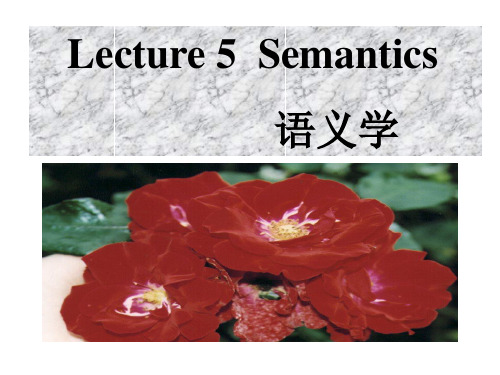
wrath:literature The Grapes of Wrath 《愤怒的葡萄》
John Steinbeck 约翰· 斯坦贝克
• cliche judo
typhoon tea versus ginseng
• Sputnik mosquito
English is particularly rich in synonyms for the historical reason that its vocabulary has come from two different sources, from Anglo -Saxon on the one hand and from French, Latin and Greek on the other.
Wrath
rage
Anger
fury
indignation
“Anger, rage, fury, indignation
and wrath” are synonymous in denoting the emotional excitement induced by intense displeasure.
Sense 意义
Vs versus
Reference 所指
• Sense is concerned with the inherent meaning of the linguistic form. • Abstract • De-contextualized • Dictionary meaning • What does the word “dog” mean in your dictionary?
A teacher was amazed to find that a lazy student had gained • mark a of 100 in an important test.
语言学第五章Semantics

语⾔学第五章SemanticsChapter Five SemanticsTeaching Focus1. What is semantics2. Meanings of “meaning”3. Sense and reference4. Sense relations5. Componential analysis --- a way to analyze lexical meaning6. Predication analysis --- a way to analyze sentence meaning1. What is semantics?Semantics is the study of meaning in language.Or specifically, it is the study of the meaning of linguistic units, words and sentences in particular.Different focus of the study in semantics:Logical semantics/philosophical semantics: Logicians and philosophers have tended to concentrate on a restricted range of sentences (typically, statements, or …propositions?) within a single language.Linguistic semantics: The linguistic approach is broader in scope, aiming to study the properties of meaning in a systematic and objective way, with reference to as wide a range of utterances and languages as possible.2. Meanings of “Meaning”The word “meaning” has different meanings.It has been studied for thousands of years by philosophers, logicians and linguists.The naming theory: Plato & AristotleWords are just names or labels for things.Can you show the limitations of this theoryThe semantic triangle: C. K. Ogden & I. A. Richards (1923) → The Meaning of Meaning.There is no direct link between a linguistic form and what it refers to. In the interpretation of meaning they are linked through the mediation of concepts in the mind. ?thought/reference (concept)symbolizes refers tosymbol/form referent(word, phrase) stands for(object)Geoffrey Leech (1974, 1981). Semantics: The Study of Meaning. Seven types of meaning:Conceptual meaningConnotative meaningSocial meaningAffective meaning associative meaningReflected and meaningCollocative meaningThematic meaning(1) Conceptual meaningIt makes the central part of meaning.Refers to logical, cognitive or denotative content.Concerned with the relationship between a word and the thing it denotes, or refers to.(2) Connotative meaningThe communicative value an expression has by virtue of what it refers to, over and above its purely conceptual content.A multitude of additional, non-criterial properties, including not only physical characteristics but also psychological and social properties, as well as typical features. ?Involving the …real world? experience one associates with an expression when one uses or hears it.Unstable: they vary considerably according to culture, historical period, and the experience of the individual.Any characteristic of the referent, identified subjectively or objectively, may contribute to the connotative meaning of the expression which denotes it.(3) Social meaningWhat a piece of language conveys about the social circumstances of its use.Dialect: the language of a geographical region or of a social class.Time: the language of the 18th c., etc.Province: language of law, of science, of advertising, etc.Status: polite, colloquial, slang, etc.Modality: language of memoranda, lectures, jokes, etc.Singularity: the style of Dickens, etc.domicile: very formal, official steed: poeticresidence: formal horse: generalabode: poetic nag: slanghome: general gee-gee: baby language (4) Affective meaningReflecting the personal feelings of the speaker, including his attitude to the listener, or his attitude to something he is talking about.Youre a vicious tyrant and a villainous reprobate, and I hate you for it!Im terribly sorry to interrupt, but I wonder if you would be so kind as to lower your voices a little. orWill you belt up.(5) Reflected meaningArises in cases of multiple conceptual meaning, when one sense of a word forms part of our response to another sense. When you hear …click the mouse twice, you think of Gerry being hit twice by Tom so you feel excited.Many taboo terms are result of this.(6) Collocative meaningThe associations a word acquires on account of the meanings of words which tend to occur in its environment.pretty: girl, boy, woman, flower, garden, colour, village, etc.handsome: boy, man, car, vessel, overcoat, airliner, typewriter, etc.(7) Thematic meaningWhat is communicated by the way in which a speaker or writer organizes the message, in terms of ordering, focus, and emphasis.Mrs Bessie Smith donated the first prize.The first prize was donated by Mrs Bessie Smith.They stopped at the end of the corridor.At the end of the corridor, they stopped.3. Sense and referenceSense and reference are two terms often encountered in the study of word meaning. They are two related but different aspects of meaning.Sense is concerned with the inherent meaning of the linguistic form. It is the collection of all the features of the linguistic form; it is abstract and de-contextualized. It is the aspect of meaning dictionary compilers are interested in.Reference means what a linguistic form refers to in the real, physical world; it deals with the relationship between the linguistic element and the non-linguistic world of experience.Every word has a sense, but not every word has a reference.Grammatical words like but, if ,and do not refer to anything. And words like God, ghost and dragon refer to imaginary things. Therefore it is suggested that we should study meaning in terms of sense rather than reference.4. Sense relationsSynonymygradableAntonymy complementaryconverseHyponymyPolysemy4.1 SynonymySynonymy refers to the sameness or close similarity of meaning. Words that are close in meaning are called synonyms. Complete synonyms are rare. According to the way they differ, synonyms can be divided into the following groups:i. Dialectal synonyms --- used in different regional dialectsBritish English American Englishautumn falllift elevatorflat apartmenttube undergroundii. Stylistic synonyms --- differing in stylekid, child, offspringkick the bucket, pop off, die, pass away, deceaseiii. Synonyms that differ in their emotive or evaluative meaningcollaborator, accompliceiv. Collocational synonymsaccuse, chargev. Semantically different synonymssurprise, amaze, astound4.2 AntonymyThe term antonymy is used for oppositeness of meaning. Words that are opposite in meaning are antonyms.There are three types of antonyms.i. Gradable: Can be modified by adverbs of degree like very; Can have comparative forms; Can be asked with how. good, badyoung, oldhot, coldii. Complementary: the denial of one member of the pair implies the assertion of the other.alive, deadmale, femalepresent, absentiii. Converse or relational: exhibit the reversal of a relationship between the pair; one presupposes the other. husband, wifebuy, sellbefore, after4.3 HyponymyHyponymy refers to the sense relation between a more general word and a more specific word. It is a kind of inclusiveness. Superordinate: the more general wordHyponyms: the more specific wordsCo-hyponyms: hyponyms of the same superordinateflower, rose, lilyanimal, cat, dogfurniture, bed, desk4.4 PolysemyPolysemy refers to the sense relation that the same one word has more than one meaning. Such a word is called a polysemic word.table: a piece of furniture; orderly arrangement of facts, figures5. Componential analysis---a way to analyze lexical meaningComponential analysis is a way proposed by the structural semanticists to analyze word meaning.The approach is based upon the belief that the meaning of a word can be dissected into meaning components, calledsemantic features.HUMANman (ADULT, MALE)woman (ADULT, FEMALE)boy (NON-ADULT, MALE)girl (NON-ADULT, FEMALE)father: PARENT (x, y) & MALE (x)x is a parent of y, and x is male.take: CAUSE (x, (HA VE (x, y)))x causes x to have y.give: CAUSE (x, (~HA VE (x, y)))x causes x not to have y.Componential analysis provides an insight into the meaning of words and a way to study the relationships between words that are related in meaning.6. Predication analysis --- a way to analyze sentence meaningThe meaning of a sentence is obviously related to the meanings of the words used in it, but it is also obvious that sentence meaning is not simply the sum total of the words.Predication analysis: proposed by the British linguist G. LeechThe basic unit in this method is called prediction. It is the abstraction of the meaning of a sentence.A predication consists of argument(s) and predicate.An argument is logical participant in a predication, largely identical with the nominal element(s) in a sentence.A predicate is something said about an argument or it states the logical relation linking the arguments in a sentence. Tom smokes.Tom is smoking.Tom has been smoking. TOM (SMOKE)Does Tom smokingTom does not smoke. argument predicateKids like apples. → KID, APPLE (LIKE)It is hot. → (BE HOT)AssignmentsHow can words opposite in meaning be classified To which category does each of the following pairs of antonyms belong?north/south vacant/occupiedliterate/illiterate above/belowdoctor/patient wide/narrowpoor/rich father/daughterhonest/dishonest normal/abnormalExercisesI. Multiple choice.1. The naming theory seems applicable to ___ only.A. verbsB. adjectivesC. adverbsD. nouns2. Hyponyms of the superordinate “flower” do not include “___”.A. wardrobeB. tulipC. lilyD. rose3. Predication analysis is a way to analyze ___ meaning.A. phonemeB. wordC. phraseD. sentenceII. Make judgments (true or false)1. In the diagram of the classic semantic triangle, the word “symbol” refers to the object in the world of experience.2. When the same one word has more than one meaning we call it a polysemic word.3. Complete synonyms, i.e. synonyms that are mutually substitutable under all circumstances, are rare in English.。
语言学_Chapter 5_Semantics

32
天亮前后,东方地平线上有时会看到一颗 特别 明亮的“晨星”,人们叫它“启明 星”;而在 黄昏时分,西方余辉中有时会 出现一颗非常明 亮的“昏星”,人们叫它 “长庚星”。这两颗 星其实是一颗,即金 星.在中国民间称它为 “太白”或“太白 金星”。古代神话中,“太 白金星”是一 位天神。古希腊人称金星为“阿 佛洛狄 忒”,是代表爱与美的女神。而罗马人 把 这位女神称为“维纳斯”,于是金星也被 称 为维纳斯了
14
M is conventional
15
What is meaning? M is conventional
A green light means ...
16
What is meaning?
Pavlov (巴甫洛夫) Meaning is Stimulus-response
17
M is flexible and imitational
25
4. Problems with the naming theory
1. The theory seems applicable to nouns only. 2. There are nouns which denote things that do not exist in the real world at all. 3. There are nouns that do not refer to physical objects, but abstract notions. 4. Some words may have different meanings in different contexts. 5. The same reference may have different names.
Charpter 5 Semantics 语义学

3.2 major sense relations
Pairs of words can be formed into certain patterns to indicate sense relations. sow/boar, ewe/ram, mare/stallion etc. form a pattern indicating a meaning related to gender.
S
r
s
R
Events before
Speech
Events after speech
speech
EXERCISE TIME 3. The well-known formula: S r…..s R was put forward by____. A. Bloomfield B. Firth C. Hockett D. Harris Answer: A
Comments on the theory: 1) Meanings don’t reside in words, but in people’s minds 2) Individual people have differences in their experiences and personal backgrounds, which affect how people think.
3.2 major sense relations
Duck/duckling, pig/piglet, dog/puppy, lion/cub, etc. form another pattern indicating a relationship between adult and young.
chapter5semantics语言学
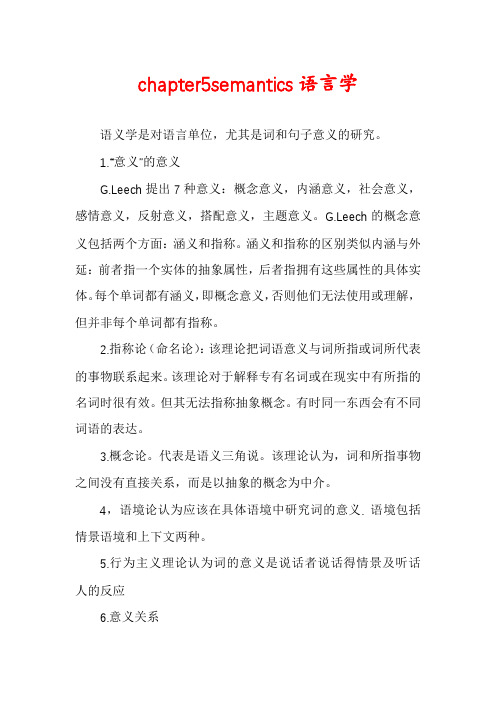
chapter5semantics语言学语义学是对语言单位,尤其是词和句子意义的研究。
1.“意义”的意义G.Leech提出7种意义:概念意义,内涵意义,社会意义,感情意义,反射意义,搭配意义,主题意义。
G.Leech的概念意义包括两个方面:涵义和指称。
涵义和指称的区别类似内涵与外延:前者指一个实体的抽象属性,后者指拥有这些属性的具体实体。
每个单词都有涵义,即概念意义,否则他们无法使用或理解,但并非每个单词都有指称。
2.指称论(命名论):该理论把词语意义与词所指或词所代表的事物联系起来。
该理论对于解释专有名词或在现实中有所指的名词时很有效。
但其无法指称抽象概念。
有时同一东西会有不同词语的表达。
3.概念论。
代表是语义三角说。
该理论认为,词和所指事物之间没有直接关系,而是以抽象的概念为中介。
4,语境论认为应该在具体语境中研究词的意义. 语境包括情景语境和上下文两种。
5.行为主义理论认为词的意义是说话者说话得情景及听话人的反应6.意义关系词语词之间的主要意义关系:相同关系,相反关系,包含关系a.同义关系。
完全同义关系很少,所谓的同一都依赖语境,并总在某方面不同。
(方言,内涵,文体等)b.反义关系主要包括:等级反义关系,互补反义关系,关系反义关系。
1)等级反义的特点:第一,否定一方并不必然是肯定另一方,还有中间状态;第二,没有绝对评判标准,标准随对象而改变。
第三,通常用其中表示较高程度的词来覆盖整个量级。
覆盖性词被称为“无标记的”,即一般性的;被覆盖词被称为“有标记的”,即特殊的。
一般使用覆盖性词语。
一旦使用被覆盖词语,表示有某种特殊的、不一般的情况。
第四,可用very修饰,可有比较级最高级2)互补反义关系,第一,肯定一方意味着否定另一方。
反之亦然。
第二,不用very修饰,没有比较级最高级。
第三,评判标准绝对。
没有覆盖性词语3)关系(反向)反义关系,表现两个实体间的一种反向关系,不构成肯否定对立。
一个预设着另一个的存在。
语言学整理的资料Chapter 5 semantics
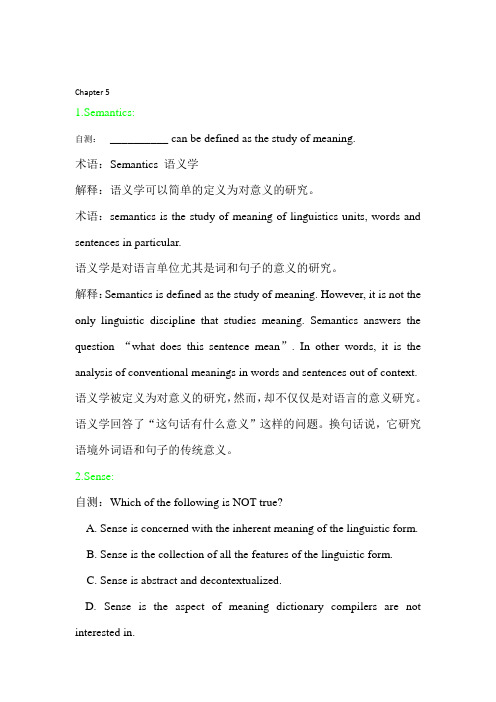
Chapter 51.Semantics:自测: __________ can be defined as the study of meaning.术语:Semantics 语义学解释:语义学可以简单的定义为对意义的研究。
术语:semantics is the study of meaning of linguistics units, words and sentences in particular.语义学是对语言单位尤其是词和句子的意义的研究。
解释:Semantics is defined as the study of meaning. However, it is not the only linguistic discipline that studies meaning. Semantics answers the question “what does this sentence mean”. In other words, it is the analysis of conventional meanings in words and sentences out of context. 语义学被定义为对意义的研究,然而,却不仅仅是对语言的意义研究。
语义学回答了“这句话有什么意义”这样的问题。
换句话说,它研究语境外词语和句子的传统意义。
2.Sense:自测:Which of the following is NOT true?A. Sense is concerned with the inherent meaning of the linguistic form.B. Sense is the collection of all the features of the linguistic form.C. Sense is abstract and decontextualized.D. Sense is the aspect of meaning dictionary compilers are not interested in.术语:Sense 涵义解释:涵义指一个实体的抽象属性。
Chapter-5-Semantics(语义学)
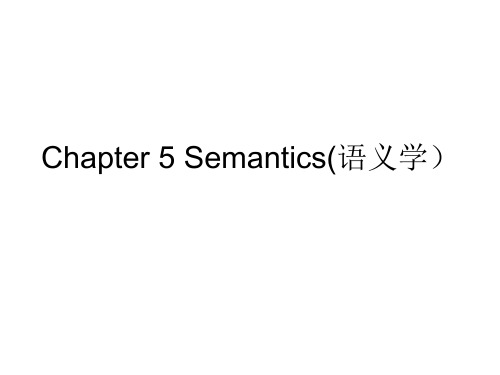
• Three types of connotative meanings: • positive(褒义), neutral(中性),negative(贬义)
• A good meal, • A good car, • A good movie, • a good road, • A good child, • good weather • A good umbrella
• A fast road, • a fast typist • A fast book • A fast decision.
the hearer (stimulus—response)
Jill is hungry and wants Jack to pick the
apple for her from the tree:
Jill
Jack
• S-------------r…….s---------------R
• 证实论:一个句子只有得到经验证实才有 意义:John is outside。
Chapter 5 Semantics(语义学)
5.1 what is semantics
• Semantics(语义学)is the study of meaning.
• What is meaning? Love, friendship, truth, fact, democracy, good, chair, ghost, unicorn;真善美,justice, soul
新编简明英语语言学教程05Chapter-5-semantics
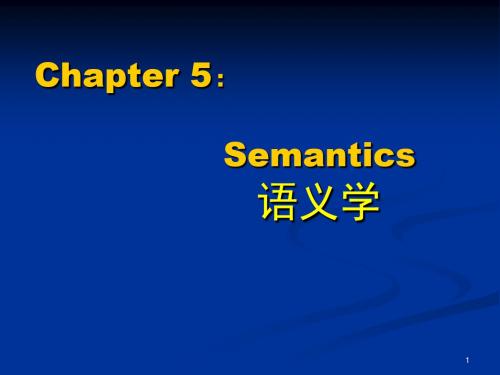
16
Note:
Linguistic forms having the same sense may have different references in different situations; on the other hand, there are also occasions, when linguistic forms with the same reference might differ in sense, e.g. the morning star and the evening star,
用符号或单词表示物体是通过言语者思 维中单词的形式与概念联系起来实现的。 从这个观点看,概念就是单词的意义。
9
Contextualism (语境论)
Meaning should be studied in terms of situation, use, context — elements closely linked with language behavior.
3
Naming theory (Plato)命名论
Words are names or labels for things.
词语只是代表物体的名字或标记。
Limitations:
1) Applicable to nouns only.
2) There are nouns which denote things that do not exist in the real world, e.g. ghost, dragon, unicorn, phenix…
语言学 第五章 semantics
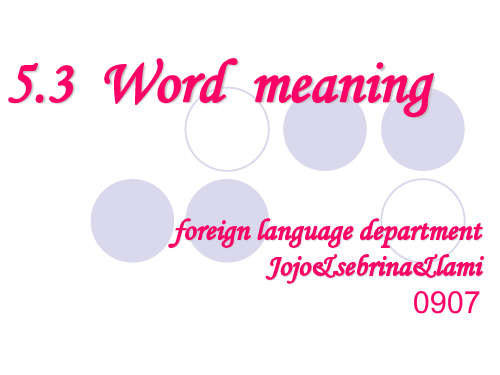
6 Collocative meaning()搭配意义
conscience
case
sky
clear
The associations a word gets because of the meanings of words which tend to occur in its linguistic context are called collocative meanings.
Thematic meaning is mainly a matter of choice between alternative grammatical • constructions. Tomorrow I plan to have an outing. I plan to have an outing tomorrow.
有意义,无指称
5.3.2 Leech’s seven types of meaning
Geoffrey Leech
From Wikipedia, the free encyclopedia Geoffrey N. Leech (Born 16 January 1936[1]) was Professor of Linguistics and Modern English Language at Lancaster University from 1974 to 2002. He then became Research Professor in English Linguistics. He has been Emeritus Professor in the Department of Linguistics and English Language, Lancaster University, since 2002.
5.semantics

the famous account of Jack and Jill (P65)
Jill
S
r
Jack
s
R
Events before speech
Events after speech
Speech
Jack passes the
“I am thirsty, Jack.” apple to Jill.
coach garage car park lay-by
tube call box telephonist
vest pavement
American English
bus service station
parking lot rest area subway telephone booth operator undershirt sidewalk
a physical stimulus
Types of word meaning
grammatical meaning lexical meaning conceptual meaning associative meaning
connotative stylistic affective collocative meaning meaning meaning meaning
5.1 What is semantics?
Semantics is generally
considered to be the study WWhhaattiisssmemeaannitnicgs??
of meaning in language.
Scholars under different scientific backgrounds have different understandings of language meaning.
Chapter 5 Semantics 语义学 语言学教程 胡壮麟
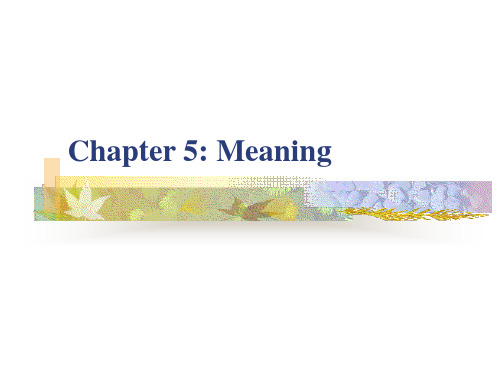
Definitions of Semantics
Semantics can be simply defined as the study of meaning. (Dai & He, 2002, p. 67) Term coined by Bré (1897) for the al subdiscipline of linguistics concerned with the analysis and description of the so-called „literal‟ meaning of linguistic expressions. (Bussmann, 1996, p. 423) Semantics is the study of linguistic meaning: the meaning of words, phrases, and sentences. (Wen, P. 210)
5.1 Meanings of „Meaning‟
Scholars like Ferdinand de Saussure have stressed that the study of linguistic meaning is part of the general study of the use of sign systems, and this general study is called semiotics.
2) It is not possible for some words to find referents in the world, such as the words but, and, of, however, the, etc. 3) Speakers of English understand the meaning of a round triangle although there is no such graph.
语言学——精选推荐

语⾔学Chapter 5 Semantics(语义学)1. Semantics: is the study of meaning.The naming theory(命名论): one of the oldest notions concerning meaning, and also the most primitive one.The limitation of this theory:a. this theory seems applicable to nouns only, but verbs, adjectives,and adverbs are definitely not labels of objectswithin the category of nouns, there are nouns which denote things that do not exist in the real world at all, and also nouns that do not refer to physical object, but abstract notions.2.意念论The conceptualist viewIt holds that there is no direct link between a linguistic form and what it refers to; rather ,in the interpretation of meaning they are linked through the mediation of concepts in the mind.3.语境论ConceptualismIt’s based on the presumption that one can derive meaning from or reduce meaning to observable contexts. her are two kinds of context: the situational and the linguistic context.4.⾏为主义论BehaviorismIt refers to the attempted to define the meaning of a language form as the” situation in which the speaker utters it and the response it calls forth in the hearer”. this theory somewhat close to conceptualism emphasizes on the psychological response.5.意义SenseIt’s concerned with the inherent meaning of the linguistic form. It’s the collection of all the features of the linguistic form, it’s abstract and de-contextualized.6.所指意义ReferenceIt means what a linguistic form refers to in the real, physical world, it deals with the relationship between the linguistic element and the non-linguistic world of experience.7.同义词SynonymyIt refers to the sameness or close similarity of meaning or we can say that words are close in meaning are called synonyms.8.多义词PolysemyIt refers to different words may have the same or similar meaning, the same one word may have more than one meaning. 9.同⾳(形)异义HomonymyIt refers to the phenomenon that words have different meanings have the same form, i.e, different words are identical in sound or spelling, or in both.10.同⾳异义HomophonesIt refers to two words are identical in sound. e.g. rain/reign.11.同形异义HomographsIt refers to two words are identical in form .e.g. tear v./tear n.12.上下义关系HyponymyIt refers to the sense relation between a more general, more inclusive word and a more specific word. the word which is moregeneral in meaning is called superordinate, and the more specific words are called its hyponyms. 13.反义词AntonymyIt’s the term used for oppositeness of meaning on different dimension. 14.成分分析法Componential Analysis----分析词汇抽象意义It’s a way proposed by the structural semanticists to analyze word meaning. this approach is based upon the belief that meaning of a word can be dissected into meaning components, called semantic features.15.述谓结构分析Predication Analysis 由British Linguist G.Leech提出It’s a new approach for sentential meaning analysis.Predication is usually considered an important common category shared by propositions, questions, commands ect.通过对论元argument和谓语predicate的分析,达到对句⼦意义进⾏分析的许多模式中的⼀种。
英语语言学概论第五章笔记
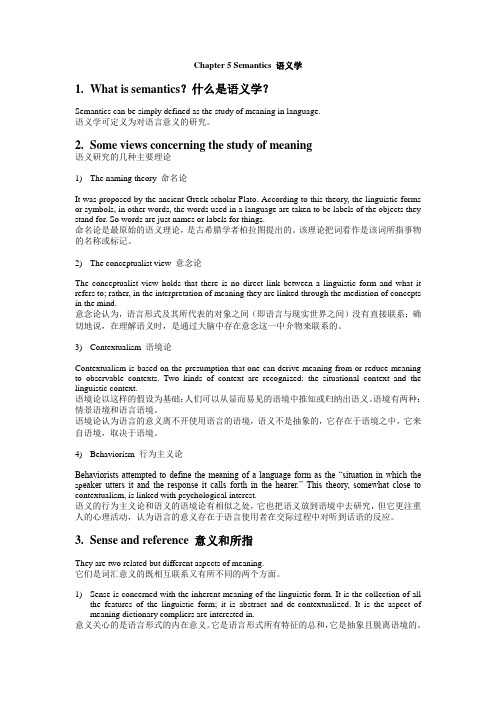
Chapter 5 Semantics 语义学1.What is semantics?什么是语义学?Semantics can be simply defined as the study of meaning in language.语义学可定义为对语言意义的研究。
2.Some views concerning the study of meaning语义研究的几种主要理论1)The naming theory 命名论It was proposed by the ancient Greek scholar Plato. According to this theory, the linguistic forms or symbols, in other words, the words used in a language are taken to be labels of the objects they stand for. So words are just names or labels for things.命名论是最原始的语义理论,是古希腊学者柏拉图提出的。
该理论把词看作是该词所指事物的名称或标记。
2)The conceptualist view 意念论The conceptualist view holds that there is no direct link between a linguistic form and what it refers to; rather, in the interpretation of meaning they are linked through the mediation of concepts in the mind.意念论认为,语言形式及其所代表的对象之间(即语言与现实世界之间)没有直接联系;确切地说,在理解语义时,是通过大脑中存在意念这一中介物来联系的。
chapter-5-semantics语义学

R: non-linguistic RESPONSE of getting the apple
1.5 Meaning as context (p.107)
Contextualist view (inspired by Malinovsky, proposed by Firth): Context determines the meaning; meaning is found in the context within which a particular expression is uttered suggests that we can derive meaning from the observable context.
Reference or extension deals with the relationship between the linguistic elements (words, sentences, etc.) and the nonlinguistic world of experience (things, actions, events and qualities).
1.2 Meaning as naming (p.105)
Naming theory (Plato): the meaning of expression is what it refers to, or names.
The semantic relationship holding between a word and the thing it denotes is the relationship of naming.
新编简明英语语言学 Chapter 5 Semantics 语义学
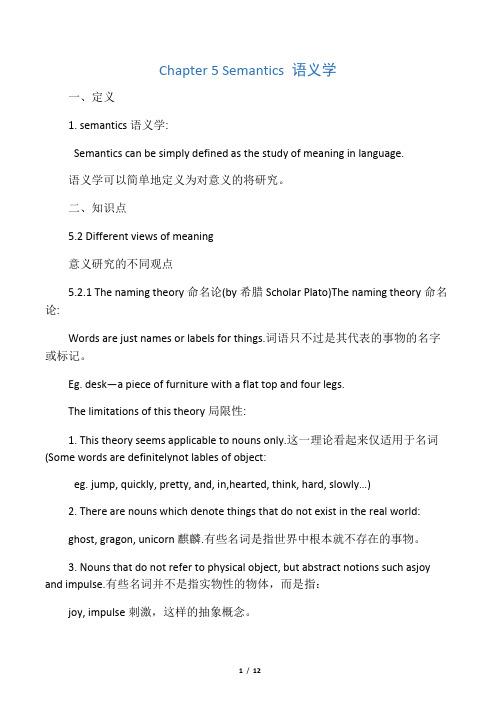
Chapter 5 Semantics 语义学一、定义1. semantics语义学:Semantics can be simply defined as the study of meaning in language.语义学可以简单地定义为对意义的将研究。
二、知识点5.2 Different views of meaning意义研究的不同观点5.2.1 The naming theory命名论(by希腊Scholar Plato)The naming theory命名论:Words are just names or labels for things.词语只不过是其代表的事物的名字或标记。
Eg. desk—a piece of furniture with a flat top and four legs.The limitations of this theory局限性:1. This theory seems applicable to nouns only.这一理论看起来仅适用于名词(Some words are definitelynot lables of object:eg. jump, quickly, pretty, and, in,hearted, think, hard, slowly…)2. There are nouns which denote things that do not exist in the real world:ghost, gragon, unicorn麒麟.有些名词是指世界中根本就不存在的事物。
3. Nouns that do not refer to physical object, but abstract notions such asjoy and impulse.有些名词并不是指实物性的物体,而是指:joy, impulse刺激,这样的抽象概念。
语义学和语用学练习1

Chapter 5 SemanticsI.Decide whether each of the following statements is True or False:1.Dialectal (方言的)synonyms (同义关系)can often be found in different regional dialects suchas British English and American English but cannot be found within the variety itself, for example, within British English or American English. F2.Sense is concerned with the relationship between the linguistic element and the non-linguistic worldof experience, while the reference deals with the inherent meaning of the linguistic form.F3.Linguistic forms having the same sense may have different references in different situations.T4.In semantics, meaning of language is considered as the intrinsic and inherent relation to the physicalworld of experience. F5.Contextualism is based on the presumption that one can derive meaning from or reduce meaning toobservable contexts. T6.Behaviourists attempted to define the meaning of a language form as the situation in which the speakerutters it and the response it calls forth in the hearer. T7.The meaning of a sentence is the sum total of the meanings of all its components. F8.Most languages have sets of lexical items similar in meaning but ranked differently according to theirdegree of formality. T9.“It is iscd:n”-place predication because it contains no argument. T10.In grammatical analysis, the sentence is taken to be the basic unit, but in semantic analysis of asentence, the basic unit is predication, which is the abstraction of the meaning of a sentence. T11.Fill in each of the following blanks with one word which begins with the letter given:11.Semantics can be defined as the study of meaning.12.The conceptualist view holds that there is no direct link between a linguistic form and what it refersto.13.Reference means what a linguistic form refers to in the real, physical world; it deals with therelationship between the linguistic element and the non-linguistic world of experience.14.Words that are close in meaning are called synonyms.15.When two words are identical in sound, but different in spelling and meaning, they are called homophones (同音/形异义词).16.Relational opposites are pairs of words that exhibit the reversal of a relationship between the twoitems.ponential (指数)analysis is based upon the belief that the meaning of a word can bedivided into meaning components.18.Whether a sentence is semantically meaningful is governed by rules called selectional restrictions,which are constraints on what lexical items can go with what others.19.An argument is a logical participant in a predication, largely identical with the nominalelement(s) in a sentence.20.According to the naming theory of meaning, the words in a lan- guage are taken to be labels of theobjects they stand for.III.There are four choices following each statement. Mark the choice that can best completethe statement:21.The naming theory is advanced by A.A.PlatoB.BloomfieldC. Geoffrey LeechD. Firth22.“We shall know a word by the company it keeps.,, This statement represents __B.A.the conceptualist view (概念)B.contexutalismC.the naming theoryD.behaviourism23.Which of the following is not true? DA.Sense is concerned with the inherent meaning of the linguistic form.B.Sense is the collection of all the features of the linguistic form.C.Sense is abstract and decontextualized (去文本化).D.Sense is the aspect of meaning dictionary compilers are not interested in.24.“Can I borrow your bike?”D“You have a bike.”A.is synonymous withB.is inconsistent withC.entailsD.presupposes25. B is a way in which the meaning of a word can be dissected into meaningcomponents, called semantic features.A.Predication analysisponential analysisC.Phonemic analysisD.Grammatical analysis26.“Alive” and “dead” are C.A.gradable antonymsB.relational opposites (关系对立)plementary antonymsD.None of the above27. A deals with the relationship between the linguistic element and the non-linguisticworld of experience.A.ReferenceB.ConceptC.SemanticsD.Sense28. C refers to the phenomenon that words having different meanings have the same form.A.PolysemyB.SynonymyC.HomonymyD.Hyponymy29.Words that are close in meaning are called D.A.homonymsB.polysemyC.hyponymsD.synonyms30.The grammaticality of a sentence is governed by A.A.grammatical rulesB.selectional restrictionsC.semantic rulesD.semantic featuresW. Define the following terms:31.Semantics32.sense33.reference34.synonymy35.polysemy36.homonymy37.homophones38.Homographsplete homonyms40.hyponymy41.antonymy42 componential analysis43.grammatical meaning44.predication45.Argument46.predicate47.two-place predicationV. Answer the following questions:48.Why do we say that a meaning of a sentence is not the sum total of the meanings of all itscomponents?49.What is componential analysis? Illustrate it with examples.50.How do you distinguish between entailment and presupposition in terms of truth values?51.How do you account for such sense relations between sentences as synonymous relation,inconsistent relation in terms of truth values?52.According to the way synonyms differ, how many groups can we classify synonyms into? Illustratethem with examples.53.What are the major views concerning the study of meaning? How they differ?Chapter 6 PragmaticsI. Decide whether each of the following statements is True or False:1.Both semantics and pragmatics study how speakers of a language use sentences to effect successfulcommunication2.Pragmatics treats the meaning of language as something intrinsic and inherent.3.It would be impossible to give an adequate description of meaning if the context of languageuse was left unconsidered.4.What essentially distinguishes semantics and pragmatics is whether in the study of meaning thecontext of use is considered.5.The major difference between a sentence and an utterance is that a sentence is not uttered while anutterance is.6.The meaning of a sentence is abstract, but context-dependent.7.The meaning of an utterance is decontexualized, therefore stable.8.Utterances always take the form of complete sentences9.Speech act theory was originated with the British philosopher John Searle.10.Speech act theory started in the late 50’s of the 20th century.11.Austin made the distinction between a constative and a performative.12.Perlocution ary act is the act of expressing the speaker’s intention.II.Fill in each blank below with one word which begins with the letter given:13.P is the study of how speakers of a language use sentences to effect successfulcommunication.14.What essentially distinguishes s and pragmatics is whether in the study of meaningthe context of use is considered.15.The notion of c is essential to the pragmatic study of language.16.If we think of a sentence as what people actually utter in the course of communication, it becomes anu.17.The meaning of a sentence is a, and decontexualized.18. C were statements that either state or describe, and were thus verifiable.19.P were sentences that did not state a fact or describe a state, and were not verifiable.20. A l act is the act of uttering words, phrases, clauses. It is the act of conveying literalmeaning by means of syntax, lexicon and phonology.21.An i act is the act of expressing the speaker’s intention; it is the act performed insaying something.22. A c is commit the speaker himself to some future course of action.23.An e is to express feelings or attitude towards an existing state.24.There are four maxims under the cooperative principle: the maxim of q, the maxim of quality, themaxim of relation and the maxim of manner.III.There are four choices following each statement. Mark the choice that can best complete the statement:25.does not study meaning in isolation, but in context.A.PragmaticsB.SemanticsC.Sense relationD.Concept26.The meaning of language was considered as something in traditional semantics.A.contextualB.behaviouristicC.intrinsicD.logical27.What essentially distinguishes semantics and pragmatics is whether in the study of meaningis considered.A.referenceB.speech actC.practical usageD.context28. A sentence is a concept, and the meaning of a sentence is often studied in isolation.A.pragmaticB.grammaticalC.mentalD.conceptual29.If we think of a sentence as what people actually utter in the course of communication, it becomesa(n).A.constativeB.directiveC.utteranceD.expressive30.Which of the following is true?A.Utterances usually do not take the form of sentences.B.Some utterances cannot be restored to complete sentences.C.No utterances can take the form of sentences.D.All utterances can be restored to complete sentences.31.Speech act theory did not come into being until.A.in the late 50’s of the 20the centuryB.in the early 1950’sC.in the late 1960’sD.in the early 21st century32.is the act performed by or resulting from saying something; it is the consequence of, or the changebrought about by the utterance.A. A locutionary actB.An illocutionary actC. A perlocutionary actD. A performative act33.According to Searle, the illocutionary point of the representative is.A.to get the hearer to do somethingB.to commit the speaker to something’s being the caseC.to commit the speaker to some future course of actionD.to express the feelings or attitude towards an existing state of affairs34.All the acts that belong to the same category share the same purpose, but they differ .A.in their illocutionary acts.B.in their intentions expressedC.in their strength or forceD.in their effect brought about35.is advanced by Paul GriceA.Cooperative PrincipleB.Politeness PrincipleC.The General Principle of Universal GrammarD.Adjacency Principle36.When any of the maxims under the cooperative principle is flouted,might arise.A.impolitenessB.contradictionsC.mutual understandingD.conversational implicaturesW・ Define the terms below:37.pragmatics38.context39.utterance meaning40.sentence meaning41.constative42.performative43.locutionary act44.illocutionary act45.perlocutionary act 46. Cooperative PrincipleV. Answer the following questions as comprehensively as possible. Give examples fOr illustration if necessary:47.How are semantics and pragmatics different from each other?48.How does a sentence differ from an utterance?49.How does a sentence meaning differ from an utterance meaning?50.Discuss in detail the locutionary act, illocutionary act and perlocutionary act.51.Searle classified illocutionary act into five categories. Discuss each of them in detail withexamples.52.What are the four maxims under the cooperative principle?53.How does the flouting of the maxims give rise to conversational implicatures?。
新编语言学教程名词解释
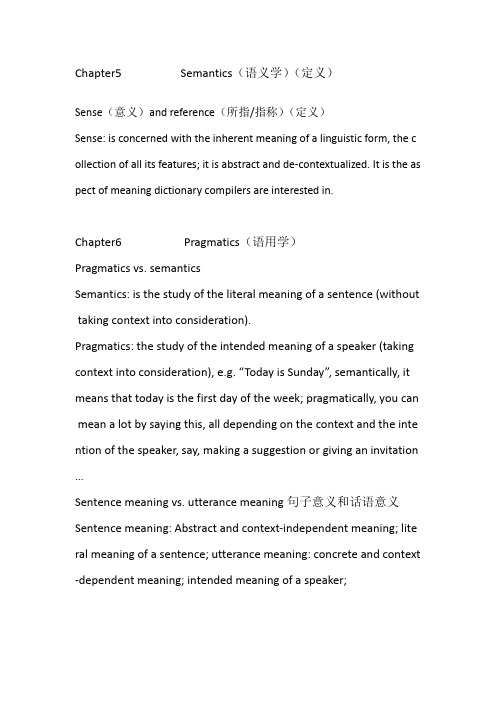
Chapter5 Semantics(语义学)(定义)Sense(意义)and reference(所指/指称)(定义)Sense: is concerned with the inherent meaning of a linguistic form, the c ollection of all its features; it is abstract and de-contextualized. It is the as pect of meaning dictionary compilers are interested in.Chapter6 Pragmatics(语用学)Pragmatics vs. semanticsSemantics: is the study of the literal meaning of a sentence (without taking context into consideration).Pragmatics: the study of the intended meaning of a speaker (taking context into consideration), e.g. “Today is Sunday”, semantically, it means that today is the first day of the week; pragmatically, you can mean a lot by saying this, all depending on the context and the inte ntion of the speaker, say, making a suggestion or giving an invitation …Sentence meaning vs. utterance meaning句子意义和话语意义Sentence meaning: Abstract and context-independent meaning; lite ral meaning of a sentence; utterance meaning: concrete and context -dependent meaning; intended meaning of a speaker;Chapter11Second Language AcquisitionConnections between first language acquisition and second la nguage acquisition:The first language study has served as a backcloth for perceiving and understanding new facts about second language learning (Littlewoo d, 1986).Positive transfer: facilitate target language learningNegative transfer: interfere or hinder target language learningIt is believed that differences between the native language and the t arget language would pose difficulties in second/foreign language le arning and teaching, e.g. *To touch the society .*There are more people come to study in the states.*I wait you at the gate of the schoolErrors & mistakesErrors: unintentionally deviant from the target language and not self -corrigible by the learner (failure in competence);Mistakes: either intentionally or unintentionally deviant forms and s elf-corrigible (failure in performance).。
自考英语语言学Chapter 5 Semantics

Chapter 5 Semantics语义学一、本章纲要二、本章重点1.What is semantics? 什么是语义学A study of meaning in language(2003填空). Linguists cannot agree among themselves as to what meaning is. Philosophers are interested in understanding the relations between linguisticexpressions and the phenomena in the real word they refer to and in evaluating the conditions of truth and falsehood of such expressions. Psychologists focus their interest on understanding the human mind through language.2.Some views concerning the study of meaning2.1 The naming theory命名论(2005单选;2007名词解释)It is one of the oldest notions concerning meaning, and also a very primitive one, proposed by Greek scholar Plato. According to his theory, the linguistic form of symbols, in other words, the words used in a language are taken to be labels of the objects they stand for. So words are just names or labels for things. 命名论是最原始的语义理论,由古希腊学者柏拉图提出。
- 1、下载文档前请自行甄别文档内容的完整性,平台不提供额外的编辑、内容补充、找答案等附加服务。
- 2、"仅部分预览"的文档,不可在线预览部分如存在完整性等问题,可反馈申请退款(可完整预览的文档不适用该条件!)。
- 3、如文档侵犯您的权益,请联系客服反馈,我们会尽快为您处理(人工客服工作时间:9:00-18:30)。
5.3.2 Major sense relations
7. (True or false): Antonymy is used for opposites of meaning.
3. Predication analysis述谓结构分析
4. predicate谓词 5. argument变元
5.2 Some views concerning the study of meaning
5.2.4 behaviorism 语境的行为主义观 1. What is the proposer of the behaviorist view of meaning? 2. What is the behaviorism view of meaning? 3. Use the story of Jack and Jill to illustrate the behaviorist view of meaning.
5.2 Some views concerning the study of meaning
5.2.2 The conceptualist view 概念论 1. What is the conceptualist view of meaning? 2. Use an example to explain the semantic triangle. 语义三角(说) thought/ reference 所指 symbol/ form 语言形式 referent 指称对象
5.3.2 Major sense relations
4. (True or false) Polysemy is that the same one word has more than one meaning. a polysemic or polysemous word 5. Term definition: homonymy homophones, homographs, complete homonyms
Chapter 5 Semantics 语义学
5.1 What is semantics?
1. Semantics is the study me views concerning the study of meaning
5.2.1 The naming theory 命名论 1. proposer 2. what is the naming theory? 3. what are the limitations of the naming theory
5.4 Sense relations between sentences
1. entailment蕴含
2. presupposition预设
5.4 Sense relations between sentences
1. componential analysis成分分析法
2. semantic features语义特征
5.3.2 Major sense relations
1. what is synonymy? 2. True or false: words that are opposite in meaning are called synonyms. 3. Different groups of synonyms according to the way they differ: (1) dialectal synonyms (2) stylistic synonyms (3) synonyms that differ in their emotive or evaluative meaning (4) Collocational synonyms (5) semantically different synonyms
5.3 Lexical meaning
5.3.1 Sense and reference 意义和所指 1. Give the definition of sense. 2. Give the definition of reference.
There are also occasions when linguistic forms with the same reference might differ in sense. E.g. morning star and evening star 均指金星Venus,在东边时是morning star启明星, 在西边时是evening star长庚星
5.3.2 Major sense relations
11. Use examples to define gradable antonyms.(分 级反义词)
12. Use examples to define complementary antonyms. (互补反义词) 13. Use examples to define relational antonyms.(关 系反义词)
8. (True or false): Words that are opposite in meaning are synonyms. 9. The three kinds of antonyms are ______, _______, and ______. 10. Use examples to define gradable antonyms.(分 级反义词)
5.2 Some views concerning the study of meaning
5.2.3 Contextualism语义的语境观 1. what is the contextualist view of meaning? 2. (True of False): J. R. Firth is a representative linguist of contextualism. 3. There are two kinds of context. They are ______ and ______. 4. What is the situational context? 情景语境 5. What is the linguistic context? 语言语境
